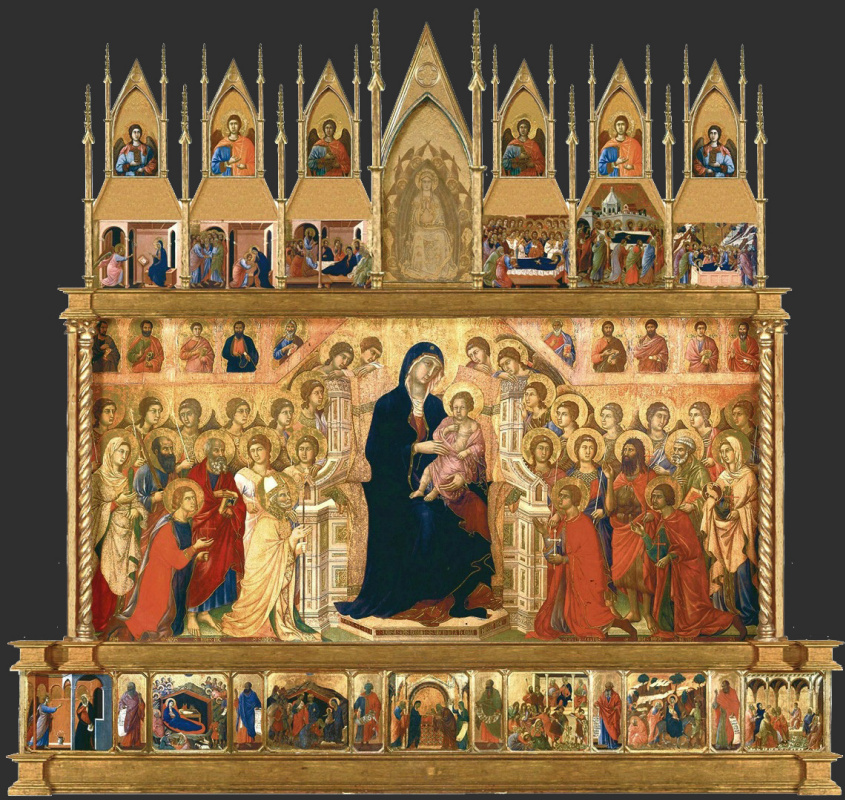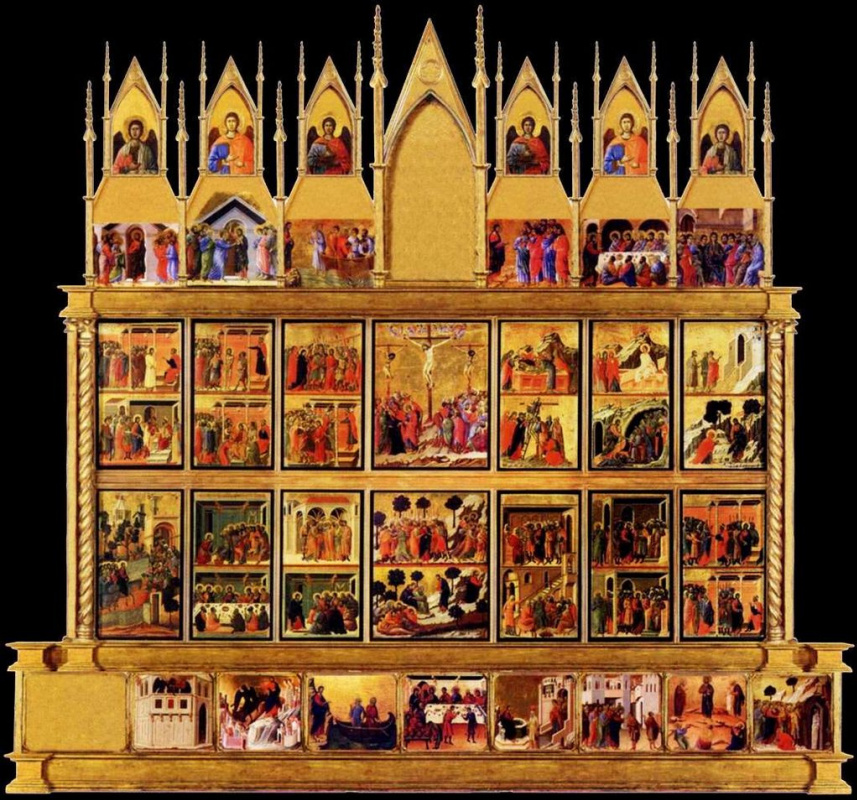log in
Enter site
Login to use Arthive functionality to the maximum
Maesta (modern reconstruction)
Duccio di Buoninsegna • Icon painting, 1311, 396×213 cm
Description of the artwork «Maesta (modern reconstruction)»
Maestas - a central work in the work of Duccio di Buoninsegna, grandiose in both execution and in size a two-sided painting, written for the altar of the main cathedral of Siena, the artist’s hometown.
So far, Maestas has been preserved only partially. Having survived a lot of barbaric vivisections, right up to crude attempts to separate the front side of the picture from the reverse, now it is fragmentary represented in different collections (from the London National Gallery to the private Frick Collection, New York). On the reproduction you can see the modern reconstruction of the Maestas. you also can consider this altar complex in detail.
The material for the altar picture was a tree. The work has two sides: the front is dedicated to the Virgin Mary, the reverse - to Christ. Both with the one and the other one can see the iconographic narrative (a consistent story) describing the main events of the earthly life of the Savior and the Blessed Virgin.
The top of the Maestas was supposedly made up of pinacles (fr. spinacle - wing, fad) - pointed turrets used in Gothic architecture, containing stigmas (small compositions on the themes of the Virgin and Christological cycles). The central plot of the front side is “The Glory of Our Lady” (Maestas proper, from Italy. maestà - exaltation, magnification). Her throne from three sides is surrounded by numerous angels, the apostles Peter and Paul, John the Theologian and John the Baptist. There are among the surrounding Madonna and local saints - St. Catherine of Siena and others.
The overall mood of the picture is extremely upbeat and solemn, which is greatly facilitated by the coloring: the glowing background and golden halos, enamel vividness of blue and red color spots, deep and expressive dark blue color of Mary's apparel. The meaning of “Maestas” by Duccio di Buoninsegna for the evolution of Italian painting is to gradually move away from speculation in the direction of a more realistic interpretation of the image. Thus, the faces of Madonna and Child are deprived of the characteristic Byzantine elongation, which can still be found in the early Duccio, they are written out more alive and rounded. Siena School of Painting differs from the Florentine is not "dramatic", and "lyrical" interpretation of the picturesque scenes. In accordance with this, the story of Christ and Mary in the Maesthe is given without pathos and anguish, but with calm and respectful attention to small details. Duccio deliberately refuses the intricate allegories characteristic of his time and makes the image deliberately accessible and vivid.
Author: Anna Yesterday
So far, Maestas has been preserved only partially. Having survived a lot of barbaric vivisections, right up to crude attempts to separate the front side of the picture from the reverse, now it is fragmentary represented in different collections (from the London National Gallery to the private Frick Collection, New York). On the reproduction you can see the modern reconstruction of the Maestas. you also can consider this altar complex in detail.
The material for the altar picture was a tree. The work has two sides: the front is dedicated to the Virgin Mary, the reverse - to Christ. Both with the one and the other one can see the iconographic narrative (a consistent story) describing the main events of the earthly life of the Savior and the Blessed Virgin.
The top of the Maestas was supposedly made up of pinacles (fr. spinacle - wing, fad) - pointed turrets used in Gothic architecture, containing stigmas (small compositions on the themes of the Virgin and Christological cycles). The central plot of the front side is “The Glory of Our Lady” (Maestas proper, from Italy. maestà - exaltation, magnification). Her throne from three sides is surrounded by numerous angels, the apostles Peter and Paul, John the Theologian and John the Baptist. There are among the surrounding Madonna and local saints - St. Catherine of Siena and others.
The overall mood of the picture is extremely upbeat and solemn, which is greatly facilitated by the coloring: the glowing background and golden halos, enamel vividness of blue and red color spots, deep and expressive dark blue color of Mary's apparel. The meaning of “Maestas” by Duccio di Buoninsegna for the evolution of Italian painting is to gradually move away from speculation in the direction of a more realistic interpretation of the image. Thus, the faces of Madonna and Child are deprived of the characteristic Byzantine elongation, which can still be found in the early Duccio, they are written out more alive and rounded. Siena School of Painting differs from the Florentine is not "dramatic", and "lyrical" interpretation of the picturesque scenes. In accordance with this, the story of Christ and Mary in the Maesthe is given without pathos and anguish, but with calm and respectful attention to small details. Duccio deliberately refuses the intricate allegories characteristic of his time and makes the image deliberately accessible and vivid.
Author: Anna Yesterday



